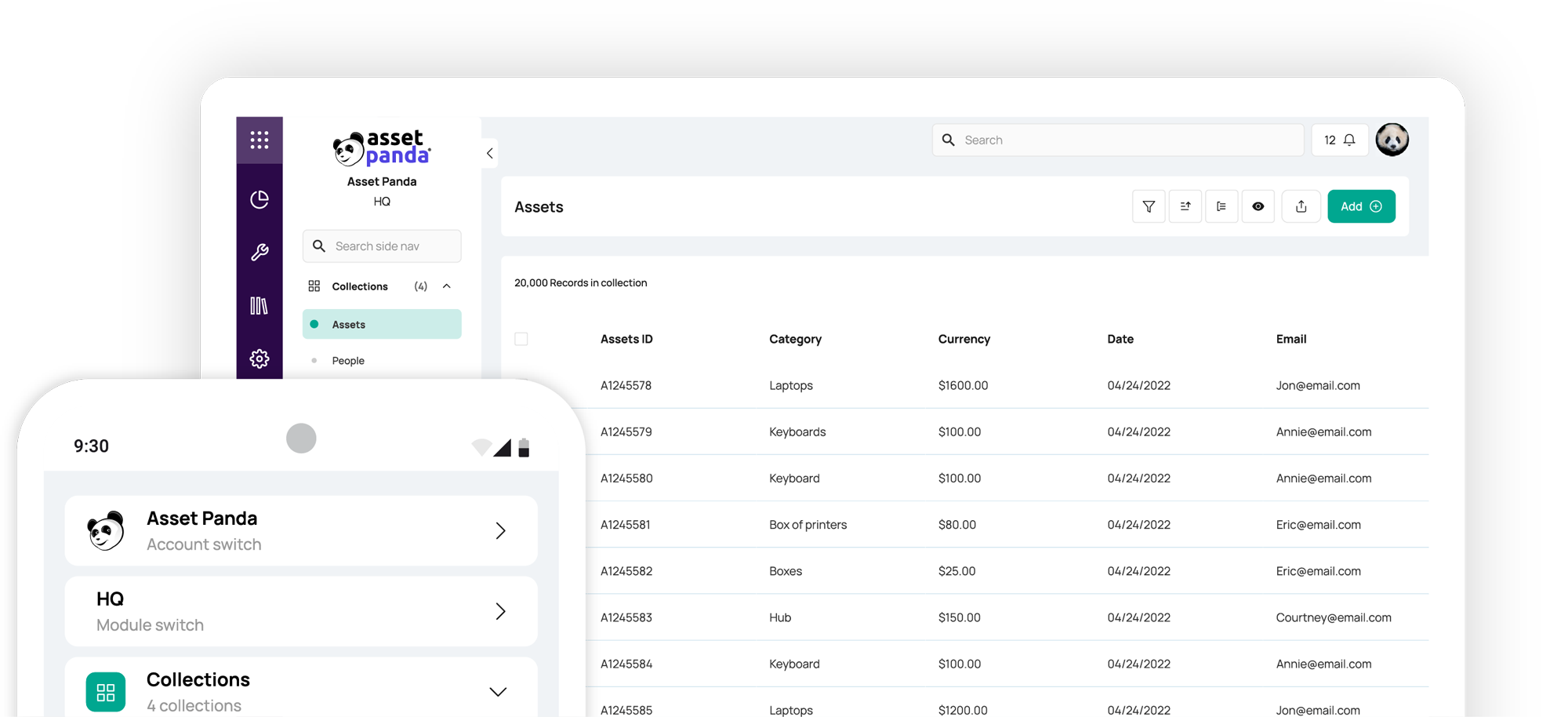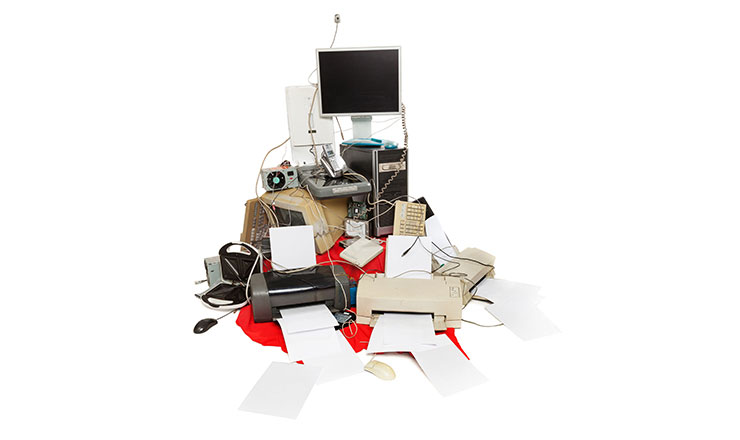How to Keep Track of Fixed Assets: A Comprehensive Guide
Blog

Table of Contents
Take Control of Your Assets
A personalized demo is just one click away.
Imagine losing track of thousands of dollars' worth of equipment, missing crucial maintenance deadlines, or failing an audit because of disorganized records. These scenarios happen more often than you’d think when businesses either don’t know how to track fixed assets or don’t have a proper fixed asset tracking system in place to do so. Whether you’re managing office computers, heavy machinery, or company vehicles, knowing how to keep track of fixed assets is essential for financial accuracy, operational efficiency, and long-term business success.
But tracking fixed assets isn’t just about keeping a spreadsheet—it's about ensuring your business runs smoothly, minimizing losses and maximizing productivity. In this guide, we’ll break down everything you need to know about how to keep track of fixed assets, from establishing your inventory to leveraging cutting-edge tracking technologies so you can keep every asset accounted for and operating at peak efficiency.
What Are Fixed Assets?
Fixed assets are long-term tangible assets that businesses use in their operations. Unlike inventory, these assets are not intended for resale. Instead, they contribute to a company’s ongoing business activities and typically have a useful life of more than one year.
Examples of fixed assets include:
- Real estate: Office buildings, warehouses, and factories.
- Equipment and machinery: Manufacturing tools, heavy equipment, and industrial machinery.
- Vehicles: Company-owned cars, delivery trucks, and forklifts.
- IT assets: Computers, servers, printers, and network hardware.
- Office fixtures and furniture: Desks, chairs, filing cabinets, and conference tables.
Why Tracking Matters
Fixed asset tracking is an essential component of business strategy that supports fiscal accuracy, streamlined operations, and risk management. Without proper tracking systems, organizations face increased risks of asset misplacement, inaccurate depreciation calculations, and compliance issues.
As businesses grow and assets are distributed across multiple locations, having a centralized, up-to-date record of fixed assets becomes even more vital for informed decision-making and long-term sustainability.
Proper tracking ensures businesses can:
- Prevent loss and theft: Knowing asset locations reduces the risk of misplaced or stolen items.
- Support accurate financial reporting: Asset values and depreciation calculations must be correctly recorded for tax and accounting purposes.
- Schedule maintenance efficiently: Keeping track of asset conditions ensures timely repairs and replacements.
- Comply with regulations: Many industries require businesses to maintain asset records for auditing and compliance purposes.
How to Keep Track of Fixed Assets
Mastering keeping track of fixed assets starts with a clear strategy and the right tools to support your processes. Whether you’re overseeing a small set of office equipment or managing hundreds of assets across multiple locations, tracking begins with three things: understanding what you have, where it is, and how it’s being used.
Effective asset tracking minimizes loss, streamlines operations, and ensures compliance with accounting standards. The following steps break down the core components of fixed asset tracking, providing a roadmap that businesses of all sizes can follow to gain control and visibility over their valuable resources.
1. Establish a Fixed Asset Inventory
Creating an asset inventory is the foundation of effective asset tracking. This involves listing all fixed assets with essential details, such as:
- Asset name and description
- Purchase date and acquisition cost
- Serial numbers or other unique identifiers
- Assigned location and department
- Responsible personnel
2. Use Asset Tags and Labels
Using barcodes, QR codes, or RFID tags simplifies tracking by assigning a unique identifier to each asset. Asset tracking tagging reduces manual data entry errors, ensures accurate record-keeping, and facilitates faster verification during inspections.
3. Implement Software
Modern software, such as Asset Panda, offers businesses a centralized platform to manage their assets. Features of tracking software include cloud-based data access, automated depreciation tracking, custom reporting and analytics, and maintenance scheduling and reminders.
4. Conduct Regular Audits and Inspections
Routine fixed asset audits help businesses verify asset locations, conditions, and utilization. Best practices for asset audits include:
- Scheduling periodic inspections by conducting quarterly or annual asset checks.
- Using scanning technology such as barcode or RFID scanners for efficiency.
- Updating asset records to confirm real-time updates in the asset tracking system.
5. Assign Responsibility for Asset Management
Designating specific employees or departments to oversee asset tracking improves accountability. When companies and their employees know how to track fixed assets, they can feel confident that records are kept up to date, they are accurately monitoring asset usage by tracking transfers and reallocation, and are enforcing compliance policies by following regulatory guidelines.
6. Monitor Asset Depreciation
Fixed assets lose value over time due to wear and tear, a process referred to as fixed asset depreciation. Tracking depreciation helps businesses maintain accurate financial statements by reflecting true asset value. Additionally, tracking depreciation can help organizations plan for asset replacements by forecasting when assets need to be upgraded, and can optimize tax deductions.
7. Establish a Clear Asset Disposal Policy
When assets become obsolete or are no longer needed, having a structured disposal policy ensures proper handling. This can be implemented by determining whether an asset can be repurposed; selling, recycling, or donating assets no longer in use or needed; and updating financial records by removing retired assets from active inventory.
8. Utilize Mobile Asset Tracking
Mobile asset tracking solutions allow employees to update asset information any time and from any location. Key benefits of mobile asset tracking include:
- Instant Barcode/RFID Scanning: Reduces manual entry errors.
- Remote Status Updates: Keep asset records current.
- Efficient Maintenance Tracking: Log maintenance and repair updates in real time.
9. Integrate with Other Business Systems
Integrating asset tracking software with accounting, procurement, and maintenance systems improves workflow efficiency by automating asset value adjustments, thereby reducing manual calculations, simplifying compliance reporting, and eliminating redundant data entry.
Overcoming Common Challenges
While tracking offers significant benefits, businesses often face challenges in maintaining an accurate and efficient system. Issues like human error, outdated records, or untracked asset transfers can lead to discrepancies that impact financial reporting and compliance. By understanding these common problems and implementing proactive solutions, businesses can optimize their asset management processes and reduce risks.
Here are four common challenges businesses face when it comes to how to keep track of fixed assets and the solution that fixed asset tracking offers:
Challenge 1: Lack of Standardized Tracking Methods
Solution: Implement company-wide tracking policies and asset management software to ensure uniform record-keeping.
Challenge 2: Manual Errors and Data Inconsistencies
Solution: Use barcode or RFID technology to automate asset updates and minimize errors.
Challenge 3: Untracked Asset Transfers
Solution: Establish protocols for updating records whenever assets change locations or ownership within the company.
Challenge 4: Compliance and Audit Risks
Solution: Maintain detailed asset histories, including acquisition dates, maintenance records, and disposal information, to meet regulatory requirements.
Future Trends
As technology continues to evolve, so does the way businesses manage their fixed assets. Forward-thinking organizations are beginning to adopt tools like artificial intelligence (AI), blockchain, and the Internet of Things (IoT) to gain deeper insights and tighter control over asset performance and movement.
AI is helping companies shift from reactive to predictive maintenance by analyzing usage data and alerting teams before equipment fails. Blockchain brings a new level of security and transparency, creating an unchangeable digital record of asset ownership and transactions. Meanwhile, IoT-enabled sensors are making real-time monitoring possible, offering instant updates on asset location, condition, and status, all without manual input.
These innovations are still emerging, but they’re quickly becoming more accessible and practical for businesses of all sizes. Embracing these asset tracking trends now can position organizations for greater efficiency, lower costs, and improved asset visibility in the years to come.
How to Keep Track of Fixed Assets with Asset Panda
Effectively managing to keep track of fixed assets requires a combination of best practices, advanced technology, and proactive asset management strategies. Implementing a structured approach that includes asset tagging, software tracking, regular audits, and mobile solutions helps businesses minimize losses, optimize asset utilization, and maintain financial accuracy.
By leveraging tools like Asset Panda, companies can enhance how to track fixed assets efficiently, ensuring seamless operations and long-term success. Asset management starts with having the right system in place. Asset Panda delivers an all-in-one platform designed to help businesses take control of their fixed assets with greater efficiency and accuracy. By simplifying the asset tracking process, Asset Panda helps organizations stay compliant, organized, and financially mindful.
With Asset Panda, you can:
- Monitor your fixed assets in real time for better oversight and transparency.
- Automate depreciation schedules to simplify your financial reporting.
- Plan and track maintenance to extend the life of your assets.
- Create in-depth reports to support audits, tax preparation, and regulatory compliance.
Asset Panda equips your business with a robust asset management solution that improves operations, lowers expenses, and most importantly, supports smarter decision-making. Request a demo today and learn how Asset Panda can help you learn how to keep track of fixed assets, setting your business up for success.
Take Control of Your Assets
A personalized demo is just one click away.
Related News & Press
Learn more from a solution specialist
Schedule a demo to find out how you can transform your workflows with Asset Panda Pro
Contact our team at (888) 928-6112



